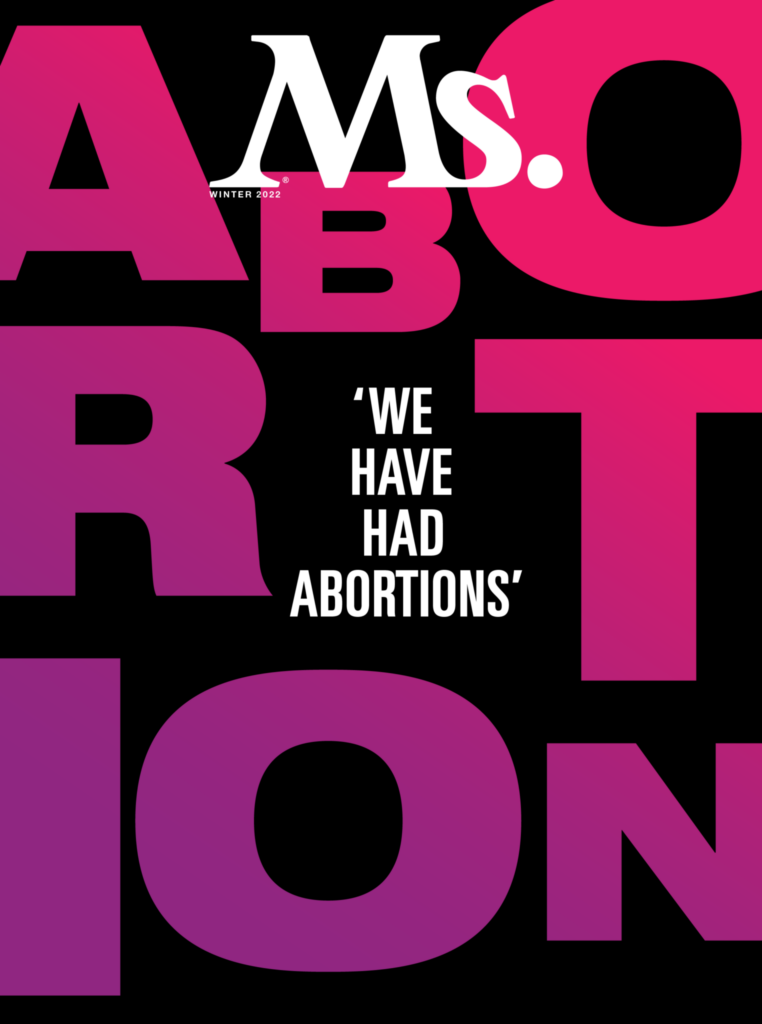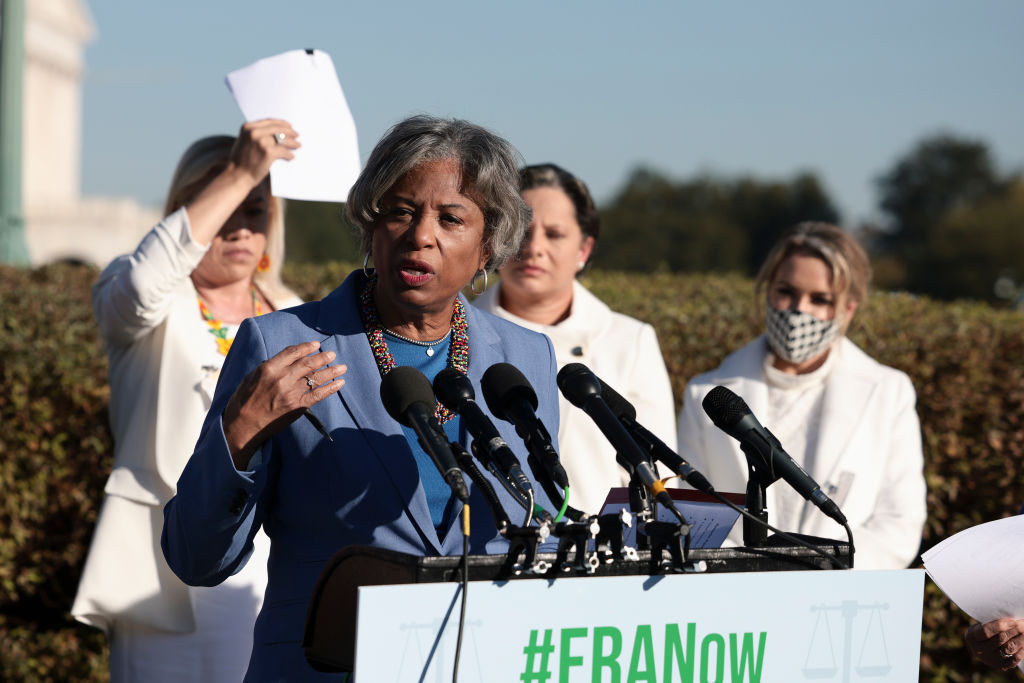On Jan. 27, two years after the 38th state ratified it, the Equal Rights Amendment should have gone into effect—yet the fight for constitutional equality continues.
Updated March 22, 2022 at 2:15 p.m. PT:
Tuesday marked 50 years since the Equal Rights Amendment was first approved by the U.S. Congress and sent to the states for ratification. To commemorate the past half-century of striving for women’s equality, Congress members and women’s rights advocates spoke out in support of the amendment.
Rep. Carolyn Maloney (D-NY), chair of the House Oversight and Reform Committee sent a letter to U.S. archivist David Ferriero, urging him to fulfill his statutory duty and publish the ERA. The letter included opinions from respected law scholars—including Laurence Tribe of Harvard and former Senator Russ Feingold, now president of American Constitution Society—all of whom concluded that the ERA has met all requirements to be officially included in the Constitution as the 28th Amendment, and that the archivist should publish it as such.
“Women and people of all marginalized genders across the United States continue to experience discrimination on the basis of sex,” wrote Maloney. “The only way to ensure true and equal protection under the law is to cement the ERA into the U.S. Constitution. As Chairwoman of the Committee with jurisdiction over the National Archives, and as a woman whose rights under the law are still not fully reflected in our nation’s founding document, I urge you to carry out your ministerial duty under the law without delay.”
Feminist Majority Foundation president Eleanor Smeal, who was in the Gallery of the Senate when it approved the Equal Rights Amendment on March 22, 1972 and has worked for its passage ever since, said on this 50th Anniversary: “Take it from me who has worked on ratification of the ERA for over 50 years, this is really difficult. Don’t make it impossible.”
Article 5 of the U.S. Constitution sets out two requirements for amendments: approval by two-thirds of both chambers of Congress and ratification by three-fourths (38) of the states. On Jan. 27, 2020, the Equal Rights Amendment finally achieved both of these requirements, but the Trump administration blocked the certification and publication of the amendment.
With a new president and control of Congress, Democrats are now fighting for recognition of the ERA as the 28th Amendment to the U.S. Constitution.
On Oct. 23, U.S. Rep. Carolyn Maloney (D-N.Y.), as chair of the House Committee on Oversight and Reform, held a hearing on the Equal Rights Amendment. ERA advocates and a leading constitutional law scholar testified before the committee members that the amendment is fully and validly ratified and is now part of the Constitution.
On Thursday, Jan. 27, Reps. Jackie Speier (D-Calif.), Maloney and 154 cosponsors announced the introduction of a resolution before the U.S. House affirming that the Equal Rights Amendment has been validly ratified and is now in effect as the 28th Amendment to the U.S. Constitution. That same day, President Joe Biden issued a statement reiterating his strong support for the ERA and urged Congress to pass the resolution: “No one should be discriminated against based on their sex—and we, as a nation, must stand up for full women’s equality.”
But Republicans are still fighting every step of the way.
The Long Battle for the ERA
In the 1970s, both parties supported the Equal Rights Amendment. The U.S. House of Representatives approved the ERA by a bipartisan vote of 354–24 in 1971. The next year, the Senate approved the ERA by another bipartisan vote of 84–8. The Equal Rights Amendment that was adopted by Congress declares, “Equality of rights under the law shall not be denied or abridged by the United States or by any state on account of sex.”
Immediately after Congress approved the ERA, states began to ratify the amendment. By 1979, 35 states had done so—but then ratifications stalled.

This article originally appears in the Winter 2022 issue of Ms.Become a member today to read more reporting like this in print and through our app.
When Donald Trump became president in 2016 and began furiously rolling back women’s rights, ERA supporters mobilized a renewed effort to achieve full ratification of the ERA. Nevada ratified the amendment in 2017, Illinois in 2018 and Virginia in 2020 to reach full ratification by 38 states as required by Article 5. Meanwhile, hostile attorneys general from Alabama, Louisiana and South Dakota—states that claim to have rescinded their ratifications—sued to block the ERA.
The final ministerial step to make a constitutional amendment official is for the U.S. archivist to verify the ratifications and then draft a formal proclamation certifying that the amendment is valid and is part of the Constitution. This certification is then published in the Federal Register and U.S. Statutes at Large and serves as official notice to Congress and the nation that the amendment process has been completed.
But these final steps were never taken. Even before Virginia ratified the ERA, the Trump-era Department of Justice’s Office of Legal Counsel (OLC) issued a 38-page opinion arguing that the three recent ratifications were invalid because they came too late. The archivist declined to certify the ERA, and the attorneys general from Alabama, Louisiana and South Dakota dropped their lawsuit.
However, attorneys general from the three final states to ratify—Nevada, Illinois and Virginia—filed suit to require the archivist to certify the ERA.
Constitutional law scholars dispute that a seven-year timeline for ratification in the preamble to the ERA passed by Congress in 1972 means recent ratifications are invalid. “States did not vote for the timeline—states voted for the text of the ERA. The timeline was in a preamble. The timeline is definitely not binding on Congress,” said Georgetown Law professor Victoria Nourse.
Constitutional law scholars also believe that the several states’ attempt to rescind their ratifications is not valid. “Article 5 speaks to ratification but not rescission,” said Kathleen Sullivan, former dean of Stanford Law School. “Article 5 describes a one-way ratchet. It does not provide for a two-way ratchet for going in and out of the process.”
“The Equal Rights Amendment has met all the constitutional requirements for the adoption of an amendment to the Constitution of the United States,” said Eleanor Smeal, president of the Feminist Majority Foundation (publisher of Ms.). “The Department of Justice is not part of the amending process, and Trump’s DOJ should not have thrown up that procedural blockade. The national archivist’s duty is to certify the ERA as the 28th Amendment.”
The House of Representatives has twice passed a joint resolution declaring the ERA validly ratified—in February 2020 and March 2021—but Republicans have used the filibuster to block the measure in the Senate. To overcome the filibuster, Democrats must either carve out an exception to the filibuster rule for the ERA joint resolution or convince 10 Republicans to vote to end the filibuster.
So far, the only Republican senators supporting the ERA joint resolution are Lisa Murkowski of Alaska and Susan Collins of Maine. Not one male Republican senator has indicated support, and Minority Leader Mitch McConnell (R-Ky.) has pledged to block the measure.
“How do they look their wives and their sisters and their mothers and their daughters in the face and say, as a Republican, we feel women should not have equal rights?” asks Rep. Brenda Lawrence (D-Mich.), who was cochair of the congressional Women’s Caucus, which is pushing hard for the ERA. “I’m optimistic. Because it’s enshrining into our Constitution that women should be treated equally, and who would be against that?”
The Equal Rights Amendment has met all the constitutional requirements for the adoption of an amendment to the Constitution of the United States.
Eleanor Smeal
Feminists Call on Administration to Act
Frustrated by decades of delay and the Trump administration’s attempt to block the ERA, feminists are now acting with urgency to ensure full recognition of the amendment.
In October, Maloney wrote a letter to President Joe Biden and Vice Presi-dent Kamala Harris urging them to withdraw the legally erroneous OLC opinion and direct the archivist to certify and publish the amendment. She then sent a letter to the U.S. archivist, David S. Ferriero, calling on him to “carry out your statutory duties to certify and publish the ERA without further delay.”
On Oct. 29, the Senate confirmed Biden’s appointment of Duke Law professor Christopher H. Schroeder as assistant attorney general for the OLC. Schroeder now has the power to withdraw the Trump administration’s OLC opinion, which would free the archivist to finally fulfill his duties.

Maloney argues that the OLC’s opinion “inserted the executive branch into a process the Constitution leaves to Congress and the states, and included a flawed legal analysis that misapplied precedent and wrongly concluded that the ERA had not met the requirements for certification and could not be revived.”
A number of preeminent constitutional scholars agree and, together with Columbia Law School’s ERA Project, they submitted a letter to Congress in October concluding that the OLC opinion should be rescinded because it was “lacking a thoroughly reasoned understanding of precedent and congressional
power under the Constitution.” The report noted, “It has been customary practice for the OLC to review and withdraw legal opinions issued by a prior administration that are legally unsound and/or do not reflect the view of the current president.” Since then, 200 more legal scholars have joined the effort.
Nourse, too, argues that the U.S. Constitution empowers Congress and the states to amend the Constitution, and provides no role in the amendment process for the executive branch of the federal government. If the ERA is certified and Republicans sue to remove the ERA from the Constitution, Nourse believes the Supreme Court should decline to hear the case.
“Are nine unelected people going to tell me that 38 states haven’t ratified this over a period of time? That seems wrong,” Nourse says. “If they want to take this case, which they should not, I think there are lots of perils for them.
“The Court is under some scrutiny for some of its justices’ actions with respect to women. The confirmation hearings, charges of sexual harassment, sexual assault,” she said, referring to Clarence Thomas and Brett Kavanaugh, who both faced credible allegations of sexual misconduct during their Supreme Court confirmation hearings. She adds, “The chief justice is very worried, as he should be, about the Court’s long-term reputation.”
How do they look their wives and their sisters and their mothers and their daughters in the face and say, as a Republican, we feel women should not have equal rights?
Rep. Brenda Lawrence
There are also perils for Republicans if they sue to have the ERA removed from the Constitution. “For me, that would be a gift that I would love to receive, unwrap and show to everyone in this country—every voter—that this is what the Republican Party stands for,” Lawrence said. “They literally do not want enshrined in our Constitution that women are equal. I tell you, midterms are coming.”

The Political Perils of Killing the ERA
A 2020 poll shows strong public support for the ERA. The vast majority of respondents—men and women; Republicans, Democrats and Independents—want the ERA, and most think the ERA is already a part of the Constitution. Nearly two- thirds believe that the ERA would have a positive impact for women.
If the archivist certifies the ERA and Republicans file a lawsuit to remove the amendment from the Constitution, they are likely to suffer politically, says polling expert Celinda Lake of Lake Research Partners, a national public opinion and political strategy research firm.
“The ERA is very, very powerful,” Lake said, “much more powerful than people understand in terms of motivating people to vote, and that’s going to be a very important factor in 2022 in particular.
“The ERA combined with Republican abortion bans could mobilize significant numbers of women voters to show up at the polls in November and vote against Republicans,” Lake added, “especially if the Supreme Court restricts abortion rights in the Mississi pi abortion ban case—Dobbs v. Jackson Women’s Health Organization—a decision due out next summer.
“Asked how they would feel if Roe v. Wade were overturned, women said they would be quite angry, they would use it as a voting criteria and be more likely to turn out to vote. For the first time, we found pro-choice voters more energized than ‘pro-life’ voters,” Lake said about recent polls.
A Supreme Court decision overturning Roe v. Wade combined with Republican attempts to remove the ERA from the Constitution could spell serious trouble for Republicans in the November elections, according to Lake.
The ERA Effect
Section 2 of the ERA empowers Congress to pass laws to address the ongoing inequality experienced by women.
“The ERA is not merely a symbol,” Maloney said. “It will make a real difference in the lives of women and people who face discrimination, sexual violence and unequal pay. The pay gap between men and women has persisted for decades. … For women of color, the gap is even wider. That is shameful, and it shows that the current legal standards are not adequate.”
Nourse gives a concrete example of how the ERA could help address violence against women. In 1994, Congress passed the bipartisan Violence Against Women Act with a civil rights remedy so survivors of violence could go to civil court to hold accountable those responsible and seek monetary damages.
“If the criminal justice system treated them poorly, they had justice in their own hands, and it worked for six years,” Nourse said. “But then in 2000, guess what happened? The Supreme Court struck it down. … That [civil rights remedy] might have helped many sexually assaulted and harassed women, including the Olympians, the survivors of [Harvey] Weinstein and others.”
The Equal Rights Amendment would not only empower Congress to pass laws addressing discrimination against women but also empower individuals to file lawsuits challenging discriminatory laws, such as abortion funding bans.
“The Supreme Court has long recognized that reproductive freedom is central to one’s equality,” said Virginia state Sen. Jennifer McClellan. “As the Court ruled in Planned Parenthood v. Casey, the ability of women to participate equally in the economic and social life of the nation has been facilitated by their ability to control their reproductive lives. Abortion is healthcare, and the ERA is about gender equality in access to healthcare, and the workplace, and in school, and every aspect of federal and state law and policy.”
The possibility that the ERA could protect abortion rights is particularly important now, given the conservative supermajority on the Supreme Court.
“If we don’t write equality into the Constitution, we could lose all of our hard-won rights like access to contraceptives and same-sex marriage, in addition to abortion rights,” Maloney said. “The ERA would strengthen abortion rights by establishing equality in the Constitution and fundamentally changing the text the Supreme Court justices are charged with interpreting—leading to better decisions in the courts. The ERA would also provide a constitutional hook for those of us in Congress to pass stronger laws that not only codify Roe v. Wade but further protect that right and expand abortion access to all.”
Nourse argues it is well past time for women to gain explicit equality protections in the U.S. Constitution: “Other than the 19th Amendment, which gave women the right to vote, women are not recognized in the Constitution’s text.”
“How many more decades must we wait for constitutional equality?” Smeal asked. “How many people must suffer? When a person is cheated out of decent wages because of sex discrimination, when gender-based violence is not adequately dealt with, when educational opportunities are denied because of sex discrimination, when essential workers—who are disproportionately women of color—are cheated out of wages commensurate with the task, we all lose.”
Section 3 of the ERA says the amendment shall take effect two years after the date of ratification, which was Jan. 27, 2020. The ERA should now be in effect. How much longer will women’s equal rights be denied? “We have to lift our voices as women,” Lawrence urges. “Vote … so that we can get in the Constitution.”
Up next:





